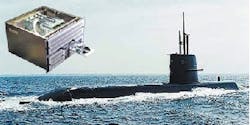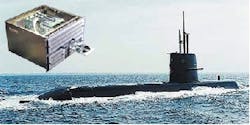Mercury's PCI-based signal processors to go on Swedish navy submarines
By John McHale
CHELMSFORD, Mass. - Engineers at Signal Processing Systems (SPS) in San Diego are using Mercury Computer Systems multicomputers originally used for medical imaging for a sonar system on Swedish navy submarines.
The SPS1000-58 Intercept and Analysis System (IntAna) will use several Race Series VantageRT PCI-based multicomputers that will enhance the signal analysis capabilities of SPS sonar systems.
The SPS1000-58 systems will be delivered to the Swedish navy under a recently awarded contract and installed on three classes of Swedish submarines during the next three years.
The SPS1000-58 IntAna performs detection and localization of anti-submarine warfare sonar pulses, torpedo pulses, and other sonar transmitting activity. It also provides the capability to perform in-depth analysis of the sonar pulses and other hydroacoustic signals, providing the submarine crews with detailed real-time information to enable faster decisions and avoid detection.
It is kind of a reverse dual-use, says Richard Jaenicke, director of strategic marketing at Mercury. Instead of military technology going into the commercial world, products developed for the commercial medical industry are finding a place in military applications, he adds.
Jaenicke attributes this to military's growing use of commercial-off-the-shelf (COTS) equipment. There is very little difference in the form factor of military and commercial industrial applications, he explains.
Mercury's PCI technology has a modular design that can be applied across markets, Jaenicke says. Without modification, Mercury engineers were able to take their medical imaging multicomputers and put them right into sonar, he explains. Both applications had basically the same form factor, Jaenicke adds.
The needs of high-speed data analysis are the same in magnetic resonance imaging, computed tomography, and digital x-ray as they are in sonar, Jaenicke says.
Because of Mercury's traditional use of Analog Devices SHARC digital signal processing chips and VME architectures, many military customers do not realize that Mercury also produces PCI-based designs, Jaenicke notes.
"We have successfully used Mercury's VME-based RACE architecture systems on other projects, where they have proven to be very effective for high-bandwidth real-time computing," says Leigh Ramsay, director of business development at Signal
Processing Systems. "Mercury's VantageRT systems are a great solution to our current need for more signal analysis processing power in a PCI-based format."
"The transition to COTS technology is proving to be successful in all types of military programs, in the U.S. and around the world," says Vincent Mancuso, vice president and general manager of the Mercury Computer Systems Government Electronics Group. "The process has reached the point where COTS suppliers such as Mercury and Signal Processing Systems can work together to provide users with affordable solutions that can be rapidly deployed and easily upgraded."
Using several PowerPC processors, users can configure VantageRT modules together to provide different levels of processing power, Mercury officials say. The VantageRT products are designed specifically to speed complex, real-time applications dealing with high-bandwidth streams of data, Mercury officials say.
Mercury's commercial off-the-shelf (COTS) multicomputer systems are available in either PCI or VME configurations, both supported by a common software development environment.

